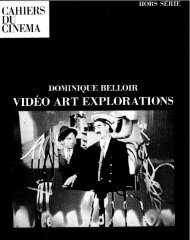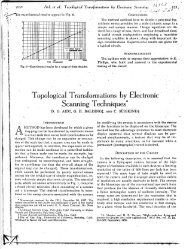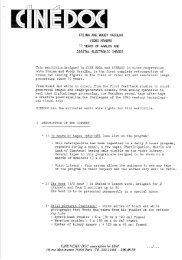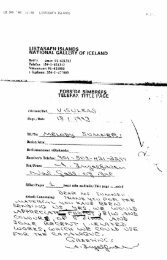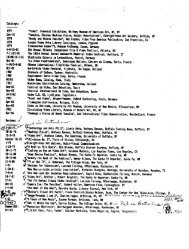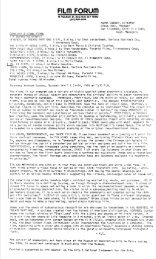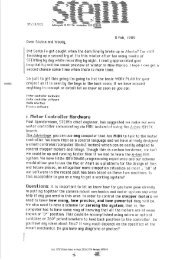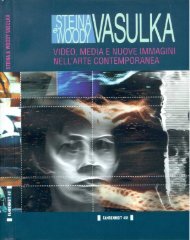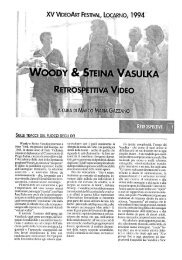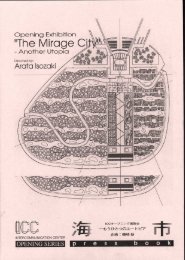MEDIA STUDY/BUFFALO - the Vasulkas
MEDIA STUDY/BUFFALO - the Vasulkas
MEDIA STUDY/BUFFALO - the Vasulkas
You also want an ePaper? Increase the reach of your titles
YUMPU automatically turns print PDFs into web optimized ePapers that Google loves.
April 11 (Wednesday)<br />
8:00 PM<br />
207 Delaware Avenue<br />
PAUL RYAN :<br />
The Work of Art in <strong>the</strong> Age of<br />
Electronic Circuitry - A lecture/<br />
discussion<br />
" 1) Television's prime mode of perception<br />
is monitoring events simultaneously<br />
with o<strong>the</strong>rs .<br />
2) Fear of television is accounted for by<br />
<strong>the</strong> fact that what television is monitoring<br />
is <strong>the</strong> increasing uninhabitability of<br />
<strong>the</strong> world, a fear displaced from <strong>the</strong><br />
world onto its monitor."<br />
- Stanley Cavell<br />
Paul Ryan's lecture is one of a series,<br />
offered in <strong>the</strong> belief that <strong>the</strong> monitoring<br />
power of television can play a<br />
significant role in current efforts to<br />
reinhabit <strong>the</strong> earth .<br />
"The Work of Art in <strong>the</strong> Age of Electronic<br />
Circuitry (is) a meditation on <strong>the</strong> topics"<br />
considered by Walter Benjamin in his<br />
classic essay, 'The Work of Art in <strong>the</strong><br />
Age of Mechanical Reproduction : The<br />
topics include aura/au<strong>the</strong>nticity/reproducibility/evidence/ritual/acting/politics/architecture<br />
as social art/etc . The<br />
. . . lecture is offered to provide <strong>the</strong><br />
listener an opportunity to see how this<br />
video reinvention of realism opens up<br />
on a set of topics not of its own<br />
assembly, and to make a statement<br />
about art in <strong>the</strong> age of electronics and<br />
ecology."<br />
- Paul Ryan<br />
,Raul Marroguin : 'I .v-nvention, segment 170 i .V .sets', 1977-78 .<br />
Image by Raul Marroquin<br />
Paul Ryan is a videomaker and<br />
author who has done extensive work<br />
using video with small groups and<br />
ecological systems since 1967. His<br />
writings are published widely and have<br />
been included in such periodicals as<br />
Media and Methods, Radical Software,<br />
CoEvolution Quarterly and Personal<br />
Computing . He is author of Cybernetics<br />
of <strong>the</strong> Sacred, published by Doubleday<br />
Anchor in 1974 and was <strong>the</strong> editor of<br />
<strong>the</strong> quarterly Talking Wood, in 1978-79 .<br />
Ryan received his B.A . in English in<br />
1967 from New York University and<br />
worked on graduate studies at Fordham<br />
University, where he was<br />
selected as principle video research<br />
assistant under Marshall McLuhan in<br />
1967-68 and where he was a McLuhan<br />
Fellow in <strong>the</strong> Media Center from<br />
1967-1970.<br />
Ryan's video works include twenty-five<br />
tapes done in collaboration with <strong>the</strong><br />
alternative video group Raindance ;<br />
Earthscore Studies; Water Chreods;<br />
Triadic Tapes; and Videowake For My<br />
Fa<strong>the</strong>r. His work has been shown at <strong>the</strong><br />
Howard Wise Gallery, Anthology Film<br />
Archives, The Kitchen Center, and over<br />
Manhattan Cable in New York City ; Optic<br />
Nerve in San Francisco ; and at <strong>the</strong><br />
Woodstock Video Festival . He is<br />
founder and president of Earthscore<br />
Foundation and is currently writing a<br />
monograph on video with support from<br />
<strong>the</strong> New York State Council on <strong>the</strong> Arts.<br />
April 18 (Wednesday)<br />
8:00 PM<br />
207 Delaware Avenue<br />
RAUL MARROQUIN -<br />
Presentation and Discussion<br />
of Videoworks<br />
Raul Marroquin is an artist based in<br />
Amsterdam and working in video,<br />
audio, performance, publishing and<br />
mixed-media . He will present<br />
documentation of several major projects<br />
- including The Link, a live interactive<br />
satellite cable melodrama, and The<br />
World's First T.V. Convention, a multimedia<br />
installation - as well as a temporary<br />
video installation piece.<br />
"The Link is <strong>the</strong> title of one episode in<br />
a TV series about <strong>the</strong> political campaign<br />
of an eccentric millionaire living<br />
in exile in a South American paradise,<br />
Senor Juan Miguel Maranas y<br />
Maranas, who has set out to gain<br />
political control over <strong>the</strong> entire planet .<br />
The Link shows <strong>the</strong> philanthropic Juan<br />
Maranas trying to obtain <strong>the</strong> support of<br />
New York by saving <strong>the</strong> city from : Vampirism<br />
. The social-cultural context of<br />
Raul Marrouquin's involvement in TV<br />
is that of South America, where TV is<br />
perhaps even more consumer<br />
orientated than in <strong>the</strong> United States -<br />
a 24-hour-long brainwash . The basic<br />
principle of TV all over <strong>the</strong> world is<br />
commercial . There is no o<strong>the</strong>r form of<br />
TV."<br />
- Josine van Droffelaar, Fandango.<br />
The World's First TV. Convention was a<br />
multi-media installation held at The<br />
Bank in Amsterdam in June of 1980.<br />
250 TV. sets were 'seated' in <strong>the</strong><br />
assembly which consisted of <strong>the</strong> tradi-<br />
Image by Paul Ryan<br />
tional groups : delegations, sectional interest<br />
groups, press representatives<br />
and non-participant audience . During<br />
<strong>the</strong> five-day conference, <strong>the</strong> sets<br />
discussed <strong>the</strong>ir specific problems .<br />
"This Fandangos invites you to take<br />
part in <strong>the</strong> debate on <strong>the</strong> complexity of<br />
<strong>the</strong> problems TV. sets have to cope<br />
with nowadays . It is a survey of <strong>the</strong><br />
discussion that arose during <strong>the</strong> TV.<br />
convention and <strong>the</strong> reactions it<br />
generated . The convention gives us<br />
better insight into <strong>the</strong> technological<br />
world of communication, but more<br />
significant is that it succeeds in making<br />
<strong>the</strong> worldwide communications networks<br />
more comprehensible. The<br />
primary goal of this review is <strong>the</strong> continuation<br />
of <strong>the</strong> dialogue that was opened<br />
during <strong>the</strong> TV. convention between<br />
man and machine ."<br />
- The Secretary of Fandangos<br />
(a/k/a Raul Marroquin)<br />
Raul Marroquin was born in Bogota,<br />
Colombia, where he received a fine<br />
arts degree at <strong>the</strong> Universidad Nacional<br />
. After completing his M.F.A . at<br />
<strong>the</strong> Jan Van Eyck Academy in<br />
Maastricht, <strong>the</strong> Ne<strong>the</strong>rlands, he moved<br />
to Amsterdam, where he currently<br />
resides . Among his works in video,<br />
audio, publishing, performance and<br />
mixed-media, Marroquin has produced<br />
a telephone installation and two<br />
records by Dutch new wave bands, The<br />
Neutronics and The Sets. His work has<br />
been exhibited internationally and he<br />
has received numerous awards, grants<br />
and fellowships for production and<br />
research in <strong>the</strong> Ne<strong>the</strong>rlands and<br />
Colombia .







